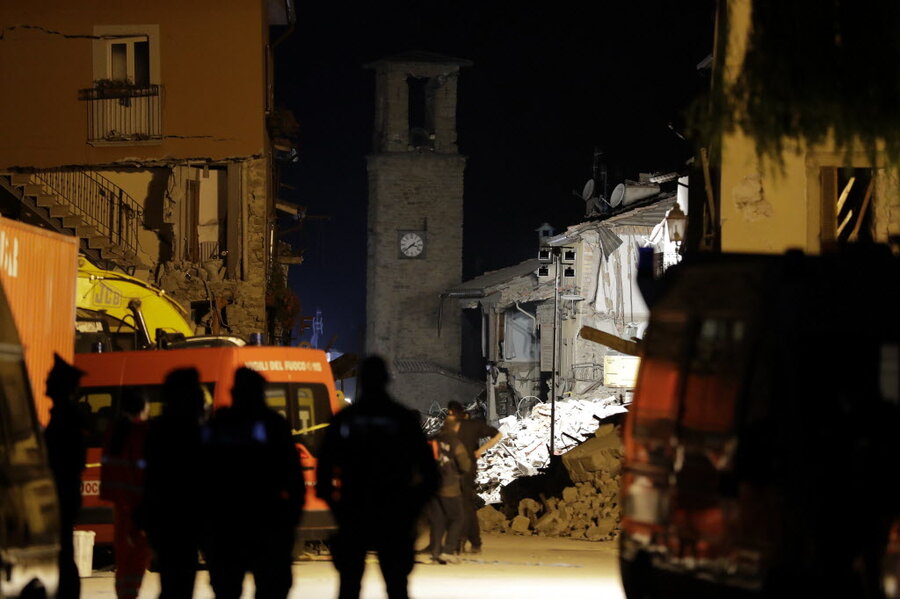Italy quake toll hits 250 as rescuers search flattened towns
Loading...
| Amitrice, Italy
The death toll from a devastating earthquake in central Italy climbed to 250 on Thursday as rescue teams scoured mounds of rubble for a second day in towns and villages flattened by the natural disaster.
The 6.2 magnitude quake struck a cluster of mountain communities 140 km (85 miles) east of Rome early on Wednesday as people slept, destroying hundreds of homes.
Dozens of emergency workers with sniffer dogs clambered over piles of debris trying to find anyone still trapped, while cranes removed huge slabs of fallen masonry and trucks full of rubble left the area every few minutes.
"People like myself have lost everything, but at the same time the fact that we have survived means we have to move forward one minute at a time," said Alessandra Cioni, 45, who managed to crawl out of her crumpled house after the quake.
"We have been saved, not like half the people in this place who have lost their lives," she said, breaking down in tears.
Prime Minister Matteo Renzi promised to rebuild the shattered houses and said he would renew efforts to bolster Italy's flimsy defenses againstearthquakes that regularly batter the country.
"We want those communities to have the chance of a future and not just memories," he told reporters in Rome.
A violent aftershock on Thursday afternoon sent rescuers fleeing as stones fell from the already severely damaged bell tower of the 15th century church of St. Augustine in Amatrice.
The jolt, which struck fear and panic in survivors, detached the church's facade, leaving it leaning dangerously over the main street where the emergency services were working under blue skies and a hot summer sun.
Almost 200 of the victims died in Amatrice, which is famed for a local pasta dish and was full of holidaymakers ahead of its 50th annual food festival, set for this weekend.
It was unclear how many visitors were in the area on Wednesday, making it hard to track the number of deaths.
"We need to know firstly the exact number of people who are missing before we can say what work is waiting for us," said fire department spokesperson Luca Cari.
"We will obviously move forward without interruption until we are sure there is no one left."
Five Romanians, one Spaniard, one Canadian and a number of other foreigners, some of them care-givers for the elderly, were believed to be among the dead, officials said.
NEGLIGENCE
Aerial video taken by drones showed swathes of Amatrice, last year voted one of Italy's most beautiful historic towns, completely flattened.
The nearby towns of Pescara del Tronto, Arquata del Tronto and Accumoli fared little better, leaving thousands of people homeless. The Civil Protection Department has sent up tents for survivors, which risk being their homes for many weeks.
Italy has a poor record of rebuilding after quakes. About 8,300 people who were forced to leave their houses after a deadly earthquake in L'Aquila in 2009 are still living in temporary accommodation.
Renzi declined to predict when the homeless might be rehoused, but said it was his government's top priority. "This is not about setting challenges and making promises. We need the pace of a marathon runner," he said.
About 365 people injured in Wednesday's quake were hospitalized, the Civil Protection said, noting that about 5,000 people, including police, firefighters, soldiers and volunteers, were involved in post-quake operations.
As night fell on Thursday, rescuers said they had pulled 215 people from the rubble, but as the hours passed only bodies were recovered, including many children who had been spending their summer holidays in the region.
Two young boys and their parents died in the nearby town of Accumoli when the church bell tower crashed through their roof. Magistrates opened an investigation into whether there had been any negligence in recent restoration work.
Another investigation was opened into why Amatrice's school had collapsed, despite the fact it had only opened in 2012 and was meant to have been earthquake-proof.
Most of the buildings in the area were built hundreds of years ago, helping to explain the widespread destruction. Cultural Minister Dario Franceschini said all 293 culturally important sites, many of them churches, had either collapsed or been seriously damaged.
Italy sits on two fault lines, making it one of the most seismically active countries in Europe. Almost 30 people died in earthquakes in northernItaly in 2012 while more than 300 died in a quake in the L'Aquila disaster.
"We are the best in the world when it comes to managing emergencies, but that is not enough," Renzi said.
"We need to change our mentality. We need a new model of development, but also of prevention. ...Everyone says this after these events, but now is the moment for all of Italy, working together, to take a leap forward."







